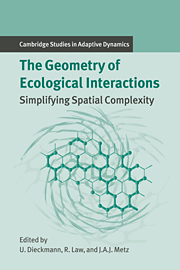Book contents
- Frontmatter
- Contents
- Contributing Authors
- 1 Introduction
- Part A Empirical and Statistical Background: A Plant Ecological Perspective
- Part B When the Mean-field Approximation Breaks Down
- Part C Simplifying Spatial Complexity: Examples
- Introduction to Part C
- 12 Spatial Scales and Low-dimensional Deterministic Dynamics
- 13 Lattice Models and Pair Approximation in Ecology
- 14 Moment Approximations of Individual-based Models
- 15 Evolutionary Dynamics in Spatial Host–Parasite Systems
- 16 Foci, Small and Large: A Specific Class of Biological Invasion
- 17 Wave Patterns in Spatial Games and the Evolution of Cooperation
- Part D Simplifying Spatial Complexity: Techniques
- References
- Index
- International Institute for Applied Systems Analysis
16 - Foci, Small and Large: A Specific Class of Biological Invasion
Published online by Cambridge University Press: 14 January 2010
- Frontmatter
- Contents
- Contributing Authors
- 1 Introduction
- Part A Empirical and Statistical Background: A Plant Ecological Perspective
- Part B When the Mean-field Approximation Breaks Down
- Part C Simplifying Spatial Complexity: Examples
- Introduction to Part C
- 12 Spatial Scales and Low-dimensional Deterministic Dynamics
- 13 Lattice Models and Pair Approximation in Ecology
- 14 Moment Approximations of Individual-based Models
- 15 Evolutionary Dynamics in Spatial Host–Parasite Systems
- 16 Foci, Small and Large: A Specific Class of Biological Invasion
- 17 Wave Patterns in Spatial Games and the Evolution of Cooperation
- Part D Simplifying Spatial Complexity: Techniques
- References
- Index
- International Institute for Applied Systems Analysis
Summary
Introduction
A particularly clear and often observed spatial pattern has multiple, roughly circular patches of a single species standing out against a different background. More often than not, this pattern is the result of the outgrowth of local colonies from sparse, randomly distributed inocula. This chapter analyzes this phenomenon from the perspective of plant pathology.
In the context of plant pathology, a focus is defined as a patch of crop with disease limited in space and time (Anonymous 1953). Here, I deal with foci due to infectious disease of plants caused by fungi. I primarily discuss polycyclic fungal diseases (i.e., diseases with many reproduction cycles per season; Zadoks and Schein 1979) of foliage in annual crops. The literature contains various publications with illustrations of foci, sometimes from aerial photography (Colwell 1956; Brenchley and Dadd 1962; van der Werf 1988). The reality of foci cannot be doubted. Their shape is usually roundish, unless the wind has exerted a great influence on spore dispersal (Brenchley and Dadd 1962; Zawolek 1993). Foci are not limited to fungal disease of foliage; they are also known for bacterial and viral diseases, plant pathogenic nematodes, and insects.
The earliest mention of “foci” caused by a soil-borne fungus dates from 1728 (Duhamel de Monceau, in Zadoks 1981). Foci reappear in the literature late in the eighteenth century for black stem rust (Puccinia graminis) of wheat or rye, and disappear again until 1896 (Eriksson and Henning 1896).
- Type
- Chapter
- Information
- The Geometry of Ecological InteractionsSimplifying Spatial Complexity, pp. 292 - 317Publisher: Cambridge University PressPrint publication year: 2000
- 1
- Cited by



